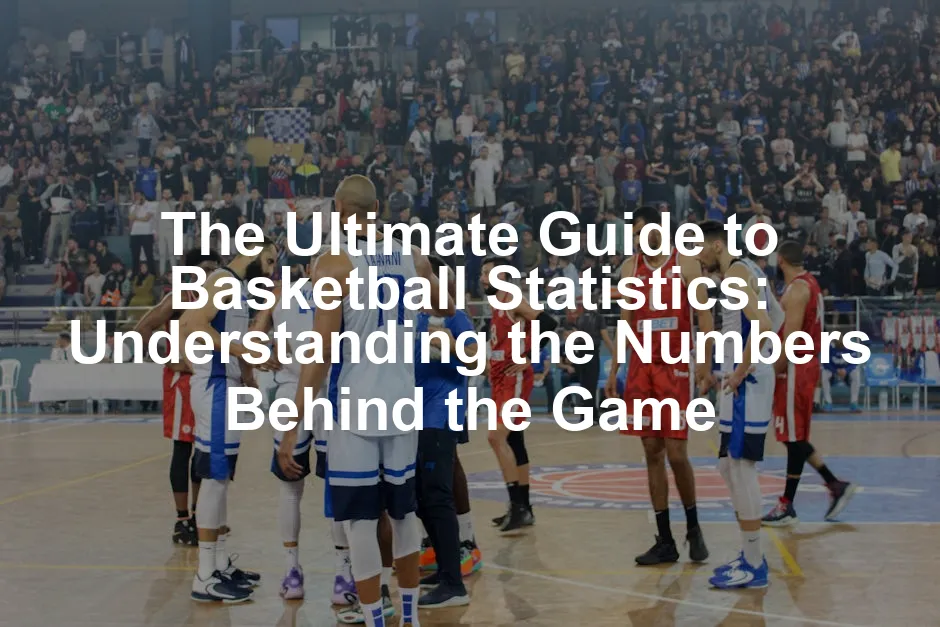Introduction
Basketball statistics are the lifeblood of the game. They provide a numerical representation of player performance, team dynamics, and game outcomes. The importance of these statistics cannot be overstated. They help fans, coaches, and analysts understand the game in a whole new light. Historically, basketball stats started with simple box scores: points, rebounds, and assists. Fast forward to today, and we have a plethora of advanced metrics. These metrics are essential for evaluating player efficiency, team strategies, and overall performance. It’s fascinating how these numbers have evolved from basic counting to complex algorithms that predict the future. As basketball continues to grow, so does the fan base’s engagement with statistics. Fans are no longer just spectators; they are analysts, using stats to appreciate the game on a deeper level. Think of it as transforming a casual viewer into a savvy expert who can recite shooting percentages like they’re the lyrics to their favorite song. In this guide, we’ll cover everything you need to know about basketball statistics. You’ll learn about the different types of stats, key statistics, and their significance in evaluating players. By the end, you’ll be equipped with the knowledge to impress your friends at your next game watch party or to dive into the world of basketball analytics yourself! If you want to dive deeper into the game, consider picking up a copy of Basketball: A Love Story. This book captures the heart and soul of the game, making it perfect for fans looking to deepen their appreciation.Understanding Basketball Statistics
What Are Basketball Statistics?
Basketball statistics are numerical data that capture the performance of players and teams. They are crucial for analyzing game dynamics and individual contributions. Statistics can be broadly categorized into basic and advanced types. Basic stats include points, rebounds, and assists—data that are easily understood and directly related to the game. Advanced statistics, on the other hand, include metrics like Player Efficiency Rating (PER) and Effective Field Goal Percentage (eFG%), which provide deeper insights into a player’s overall value and efficiency. For those interested in honing their skills, a The Art of Basketball: A Guide to Shooting, Passing, and Dribbling is a fantastic resource that will elevate your game.Key Statistics in Basketball
Points Scored
Points scored are the most straightforward metric in basketball. They represent the total number of points a player accumulates through field goals and free throws. Tracking points is crucial for assessing a player’s scoring ability and contribution to their team’s success. For instance, players like Luka Doncic and Giannis Antetokounmpo consistently rank among the top scorers in the NBA, averaging over 30 points per game. Want to keep track of your own stats? Consider using a Basketball Stats Notebook, where you can jot down all your game highlights and analyze your performance like a pro.Shooting Percentage
Shooting percentage is another vital statistic. It includes field goal percentage (FG%), three-point percentage (3P%), and free throw percentage (FT%). These percentages tell us how effectively a player converts shooting opportunities. For example, Stephen Curry, renowned for his shooting prowess, boasts a remarkable three-point shooting percentage that often exceeds 40%. This statistic can reveal a player’s strengths and weaknesses and help coaches strategize accordingly. If you’re a gamer, you might want to check out NBA 2K23. It’s a fantastic way to experience the game and improve your skills in a virtual environment.Rebounds
Rebounding is essential in basketball. It determines possession and can significantly impact game outcomes. There are two types of rebounds: offensive and defensive. Offensive rebounds give teams second-chance opportunities, while defensive rebounds help secure possession after an opponent’s missed shot. Players like Rudy Gobert excel in rebounding, often leading the league with averages around 12 rebounds per game. Understanding rebounding stats can provide insights into a team’s defensive and offensive effectiveness. To enhance your rebounding skills, consider investing in Basketball Training Equipment Set. It’s a great way to practice your skills and improve your game. As we dive deeper into basketball statistics, we’ll uncover more key metrics that shape the game. Stay tuned for insights on assists, steals, blocks, and advanced statistics that reveal the nuances of player performance.Assists, Steals, and Blocks
Assists, steals, and blocks are crucial statistics in basketball. They showcase a player’s all-around ability and impact on the game. Let’s break them down. Assists are the cherry on top of a well-executed play. They occur when a player passes the ball to a teammate in a way that leads to a score. This stat highlights a player’s vision and unselfishness. The more assists a player dishes out, the more they contribute to their team’s success. For example, James Harden is known for his exceptional passing skills. He frequently leads the league in assists, showcasing his ability to create scoring opportunities for his teammates. Next up are steals. A steal happens when a defensive player legally takes the ball away from an offensive player, disrupting their offense. This stat reflects a player’s defensive prowess and quick reflexes. Steals can shift the momentum of a game faster than a squirrel on caffeine. Consider Marcus Smart, the 2022 NBA Defensive Player of the Year. His relentless defensive efforts regularly place him among the league leaders in steals, proving how impactful this statistic can be. Finally, we have blocks. A block occurs when a defensive player deflects or stops an opponent’s shot attempt. This statistic not only shows defensive skill but also intimidates opposing players. Rudy Gobert is a prime example of a player who excels in this category. His towering presence often leads him to lead the league in blocks, making him a formidable force in the paint. In summary, assists, steals, and blocks are vital components of basketball statistics. They encapsulate a player’s overall impact on the game, showcasing not just scoring abilities but also defensive contributions and playmaking skills. Understanding these stats helps fans appreciate the intricacies of basketball performance and the roles players fulfill on the court.The Importance of Context in Statistics
Understanding Situational Statistics
Statistics in basketball can be as slippery as a wet floor. Why? Because numbers alone don’t tell the whole story. Different game situations can significantly influence a player’s performance metrics. For instance, a player may shine in regular season games, but what happens when the clock ticks down in a playoff game? Take clutch moments, for example. In the dying seconds of a close game, the pressure mounts. A player might score a game-winning shot, but what about their overall shooting percentage? If they missed half their attempts leading up to that moment, is that one basket enough to erase those faults? Context is crucial. Analyzing statistics without considering the opponent’s quality can lead to delusions of grandeur. A player might score 30 points against a struggling team, but what does that really mean when they face a top-tier defense? The same 30 points against the likes of the Milwaukee Bucks could look entirely different. Therefore, evaluating stats in context is essential to avoid misleading conclusions.Case Studies
Let’s talk about some notable players, shall we? Russell Westbrook is a prime example. Known for his impressive triple-doubles, he’s often lauded for his statistical prowess. But wait! Critics argue that his decision-making can be questionable. A high assist count doesn’t always equate to smart play. Sometimes, it’s about being in the right place at the right time, not just racking up numbers. And then there’s the role of coaches. They are the unsung heroes behind the stats. Coaches use data to make strategic decisions during games. They analyze player matchups and adjust plays based on who is hot (or not) that night. Imagine a coach looking at shooting percentages and realizing that a player is on a cold streak. It’s time to adjust the game plan rather than force feed the ball to someone who’s struggling. In high-pressure situations, coaches lean heavily on situational statistics to guide their decisions. They consider not just the numbers but the context behind them. This approach ensures that the team is always playing to its strengths while also adapting to the current game dynamics.How Statistics Influence Team Strategy
Data-Driven Decision Making
Today’s NBA teams are like data-driven machines. They harness the power of statistics to shape everything from player development to game strategy. Whether it’s adjusting offensive schemes based on shooting percentages or defensive strategies tailored to opponents, stats are the backbone of decision-making. Imagine a team that notices its offensive efficiency dips when a particular player is on the court. By analyzing the data, coaches can make informed choices about substitutions. This approach helps maximize scoring potential while minimizing defensive liabilities. For instance, if a team discovers that their three-point shooting dramatically improves with a specific lineup, you can bet they’ll lean on that combo during critical stretches.The Impact on Player Contracts
Statistics don’t just affect game strategy; they can make or break player contracts. In the NBA, performance metrics are scrutinized during negotiations. A player’s points per game, shooting efficiency, and overall impact on team success are all assessed. When teams scout potential trades or draft picks, they rely heavily on analytics. A player who might not seem like a superstar at first glance could be undervalued based on traditional stats alone. Advanced analytics can reveal hidden gems who might elevate a team’s performance beyond what basic numbers indicate. Just think of it like dating. You might look at someone’s profile and see a few basic attributes, but it’s the deeper qualities—like personality—that really matter. The same applies to basketball. Teams that dig deeper into player statistics often find the right fit for their roster, leading to better overall performance. So, whether it’s refining team strategies or negotiating contracts, the importance of context in basketball statistics can’t be overstated. By understanding the situation, analyzing the data, and applying it effectively, teams can make smarter decisions that enhance their chances of winning. And in the end, isn’t that what it’s all about?Future of Basketball Statistics
Trends in Sports Analytics
Basketball is entering a technological renaissance. Wearable devices have become the new best friend of players and teams. Imagine tracking every jump, sprint, and even heart rate during games! These gadgets are not just fancy toys; they provide real-time data that can enhance performance. Coaches can now analyze a player’s stress levels or fatigue, deciding when to pull them from the game like a pit crew at a NASCAR event. Video analysis has taken things a step further. Coaches and analysts can now dissect every moment of the game. They can pinpoint exactly where a player shines or where they stumble. This technology allows for a detailed breakdown of plays, offering insights that were once buried in the chaos of live action. Teams can now study opponent trends, identifying weaknesses to exploit. As these technologies advance, they will redefine player evaluation. No longer will teams rely solely on traditional stats like points and rebounds. Instead, they’ll look at comprehensive data sets to gauge a player’s impact. Imagine being able to predict a player’s future performance based on their current stats! Fan engagement is also set to skyrocket. With better access to statistics, fans can become mini-analysts themselves. Websites and apps are emerging, offering user-friendly platforms where fans can explore in-depth stats. This transformation allows fans to take a front-row seat in understanding the game, making discussions at water coolers way more interesting.The Role of Fans
Fans now have the opportunity to dive deep into basketball statistics, enhancing their appreciation for the game. With a few clicks, they can access a treasure trove of information. Websites like Basketball Reference and NBA Stats provide comprehensive stats, including advanced metrics, player comparisons, and historical data. Understanding these statistics can transform a casual fan into a basketball savant. For example, grasping concepts like Player Efficiency Rating (PER) or True Shooting Percentage can illuminate why a player is more than just a pretty stat line. Fans can observe how players contribute to their teams beyond just scoring points. For those wanting to take their analysis to the next level, resources like podcasts and YouTube channels dedicated to basketball analytics are emerging. These platforms break down complex statistics into digestible content, making it easier for everyone to understand the numbers behind the game. Engaging with statistics opens the door to a whole new dimension of the sport. It fosters discussions about strategies and performances, allowing fans to contribute meaningfully to conversations about their favorite teams and players. With the right tools, fans can turn a simple game night into an analytical showdown.FAQs
What are the most common basketball statistics?
Basketball statistics come in two flavors: basic and advanced. Basic stats include points, rebounds, assists, steals, and blocks. These figures are straightforward and easy to understand. Advanced stats give us a deeper look. Think of Player Efficiency Rating (PER) or Effective Field Goal Percentage (eFG%). They reveal how efficient a player is in their role.
How do advanced statistics differ from traditional stats?
Traditional stats like points and rebounds are surface-level. They tell us what happened but not how effectively it happened. Advanced stats, however, consider context. For example, PER evaluates a player’s overall contributions, accounting for playing time and team dynamics. It’s like comparing apples to oranges—both are fruit, but one is way more nutritious!
How can fans access basketball statistics?
Fans have a treasure trove of resources at their fingertips. Websites like Basketball Reference and NBA Stats offer comprehensive statistics on players and teams. Want the latest game scores or historical data? These platforms have got you covered. Plus, you can find advanced metrics, making you the smartest fan in the room!
Why are statistics important for player evaluation?
Statistics are the backbone of player evaluation. They provide measurable data to assess performance. Coaches and scouts analyze stats to make informed decisions about trades, drafts, and contracts. A player who scores 20 points a game might look good, but if they have a low shooting percentage, that tells a different story. Stats help separate the stars from the role players, ensuring teams make smart choices on and off the court.
For those interested in exploring the depth of basketball statistics, you can find more information on basketball statistics.














All images from Pexels




